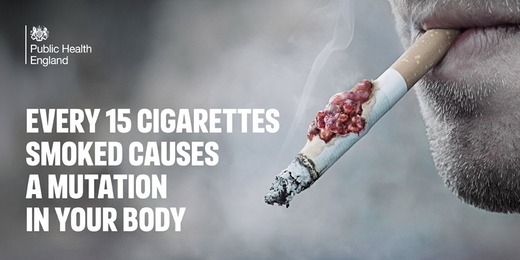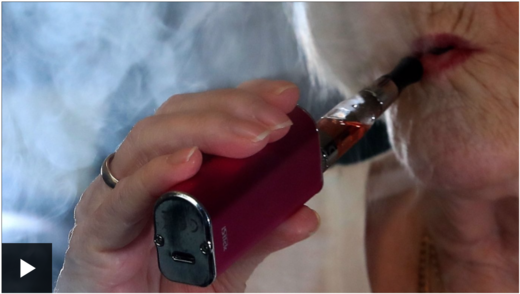Welcome back. Hope you're enjoying a well-earned Christmas break.
Apologies for the lack of posts this month. I've either been travelling (Ireland, Scotland) or busy on other things.
I intended to resume blogging next week but I couldn't let the launch of Public Health England's new anti-smoking campaign pass without comment.
According to the press release issued before Christmas but embargoed until Friday:
Public Health England (PHE) has released a new film showing the devastating harms from smoking and how these can be avoided by switching to an e-cigarette or using another type of quit aid. The film has been released as part of PHE’s Health Harms campaign, which encourages smokers to make a quit attempt this January by demonstrating the personal and irrefutable harm to health from every single cigarette [my emphasis].
The film features smoking expert Dr Lion Shahab and Dr Rosemary Leonard carrying out an experiment to visually demonstrate the high levels of cancer-causing chemicals and tar inhaled by an average smoker over a month, compared to not smoking or using an e-cigarette. The results of the experiment visually illustrate the stark contrast between the impacts of smoking and vaping. Research estimates that while not risk-free, vaping is at least 95% less harmful than smoking.
Now, I don't dispute that the risks associated with vaping appear to be very small compared to the risks associated with smoking.
I do however take issue with PHE's campaign video which goes beyond informing smokers about the relative risks and is designed – yet again – to shock smokers into quitting.
The slick two-minute video begins with a voiceover:
"Every cigarette you smoke causes tar to enter your body and spread poison throughout your bloodstream, poison that can cause heart disease, cancer and stroke."
It then cuts to Dr Shahab and Dr Leonard who have designed an experiment that ‘mimics the effects of inhaling tobacco smoke, e-cigarette vape and normal air into the lungs, with the lungs represented by three bell jars filled with cotton wool’ (Independent).
Examining the cigarette bell jar at the end of the experiment, Dr Leonard finds ‘the cotton wool in the tobacco bell jar is brown, the inside of the bell jar is brown and the tube leading to the air pump is thick with tar’.
In the video she comments:
"I mean, it's just so revolting. Look at this, that's just inside the jar. Here, a lump of tar. So that's what's going on inside your lungs. There's loads of it and this is only after one month."
Leaving no-one in any doubt about her feelings, this is followed by what sounds like an exasperated sigh or possibly "Ugh!".
In contrast the e-cigarette bell jar gets an almost clean bill of health. There’s evidence of ‘water vapour on the side and one cotton wool ball features some minor discolouration from the colouring in the e-liquid’.
Led by ASH and Fresh North East, the anti-smoking industry was quick to voice its approval. Deborah Arnott, CEO of ASH, was so enthused she posted only her third tweet of the year. (Go, Deborah!)
Vaping advocates also welcomed what one called the "good news".
What the PHE video doesn't address is this: if the lungs of regular smokers are equally "revolting", why are they frequently given to lung transplant patients?
You may recall this report from 2014 (Donor lungs from heavy smokers appear safe for transplantation):
Almost half of lung transplant patients were given the lungs taken from heavy smokers, with one in five coming from donors who had smoked at least one packet of cigarettes a day for 20 or more years.
Despite this, new research shows that those people given the lungs of smokers were just as likely to be alive up to three years after transplantation as those who had organs from non-smokers. In some cases, they had improved survival rates.
"Donor lungs from even heavy smokers may provide a valuable avenue for increasing donor organ availability," says André Simon, director of heart and lung transplantation and consultant cardiac surgeon at Royal Brompton and Harefield NHS Trust.
"Our findings provide for the first time real world figures for the perceived risk of implantation of lungs from donors with even a heavy smoking history, and they show that such donor lungs may provide a much-needed lease on life to the critically ill patient whose chances of survival diminish with every day or week that passes by on the waiting list.
A few weeks later the March 2014 issue of the Annals of Thoracic Surgery confirmed that:
Transplanting lungs from donors with a history of heavy smoking does not appear to negatively affect recipient outcomes following surgery.
The PHE campaign ignores this uncomfortable truth, preferring to shock smokers and impress the media with simplistic propaganda.
It reminds me of another new year campaign that claimed that:
"When you smoke the chemicals you inhale cause mutations on your body and mutations are how cancer starts. Every 15 cigarettes you smoke will cause a mutation. If you could see the damage you would stop."
Some of you may remember it because in a complaint submitted to the Advertising Standards Authority Forest challenged the claim that "Every 15 cigarettes you smoke will cause a mutation".
The procedure was long and arduous (it took 18 months and I wrote about it several times) but during that time the ASA upheld Forest's complaint THREE times before the ASA Council eventually overruled its own executive following repeated appeals by the Department of Health.
In my view, however, it was a moral victory for Forest.
The point I am trying to make is this. I don’t dispute that vaping is significantly safer (in terms of risk) than smoking and I applaud efforts to educate consumers about the relative risks.
There’s a fine line however between education and propaganda and PHE’s Health Harms campaign is a classic example of the latter.
I’m not surprised that the anti-smoking industry has bought into it but it saddens me that vapers (and vaping advocates) are equally happy to endorse such obvious scaremongering.
It’s worth noting too that on Boxing Day, in the wake of reports that PHE want to introduce calorie caps in food to reduce obesity , several ‘libertarians’ called for the abolition of the taxpayer-funded quango.
One man-child repeated the mantra ‘Abolish PHE’ 17 times in a single tweet. Needless to say, when PHE picks on smoking, such comments melt away.
As I say, I don’t dispute that vaping is significantly less harmful than smoking (and possibly not harmful at all) but the tacit (and lazy) endorsement of PHE’s anti-smoking propaganda is nauseating.
It also comes with a heavy price because, as we have seen, it has emboldened PHE to move on to food and drink without fear of serious reprisal.
So to those who are happy to support - silently or otherwise - PHE’s latest anti-smoking initiative, I say “Be careful what you wish for.”
Scaremongering propaganda, even in the name of health and even when the target is smoking, is fundamentally wrong. If you can’t see that you have no right to describe yourself as liberal, let alone libertarian.
PS. Interesting to note that PHE has apparently claimed ownership of the controversial ‘15 cigarettes/mutation’ campaign despite the fact that PHE was established on April 1, 2013, several months after the campaign was launched by the Department of Health in December 2012.
As already mentioned, Forest challenged the claim that “Every 15 cigarettes you smoke will cause a mutation” and the Advertising Standards Authority upheld our complaint three times before the part-time ASA Council overruled the decision of its full-time executive.
See also: On the record - that Forest/ASA correspondence in full.
This week, in a tweet promoting its new campaign, PHE bizarrely chose to resurrect the seven-year-old image below. Go figure.

